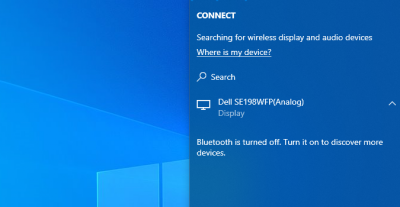Unlocking Connectivity: Transforming Your PC into a Wireless Display in Windows 10

In the evolving landscape of digital connectivity, the ability to seamlessly share content across devices is essential for collaboration, entertainment, and productivity. Windows 10 introduces a powerful feature that allows users to transform their PCs into wireless displays, enabling other compatible devices to mirror their screens wirelessly. This functionality opens up a world of possibilities, from extending your desktop to a secondary device to sharing presentations, videos, and more with ease. In this comprehensive guide, we’ll explore the process of turning a PC into a wireless display in Windows 10, delve into the benefits of this feature, and provide practical tips for optimizing your wireless display experience.
Understanding Wireless Display in Windows 10:
Wireless Display, also known as Miracast, is a technology that enables users to wirelessly transmit the display output of one device to another compatible display device. In the context of Windows 10, users can utilize this feature to turn their PCs into wireless displays, allowing other devices such as laptops, tablets, or smartphones to mirror their screens wirelessly. This functionality is particularly useful for scenarios where users want to extend their desktop to a secondary display, share multimedia content, or facilitate presentations without the need for physical cables or adapters.
Key Features and Benefits:
Turning a PC into a wireless display in Windows 10 offers several key features and benefits:
- Screen Mirroring: Users can mirror the display output of their Windows 10 PC to other compatible devices wirelessly, enabling seamless content sharing and collaboration.
- Extended Desktop: The wireless display functionality allows users to extend their desktop to a secondary device, providing additional screen real estate for multitasking or presentations.
- Flexible Connectivity: Wireless display eliminates the need for physical cables or adapters, providing a convenient and flexible solution for sharing content across devices.
- Cross-Platform Compatibility: Windows 10’s wireless display feature is compatible with a wide range of devices and operating systems that support Miracast, including Android, iOS, and other Windows devices.
- Enhanced Collaboration: With the ability to wirelessly mirror screens, users can easily collaborate on projects, share documents, and deliver presentations in meetings, classrooms, or any other collaborative environment.
How to Turn a PC into a Wireless Display in Windows 10:
The process of turning a PC into a wireless display in Windows 10 involves a few simple steps:
- Check Compatibility:
- Ensure that both the sending device (the Windows 10 PC) and the receiving device (the target display device) support Miracast or wireless display functionality.
- Enable Wireless Display:
- On the sending device (the Windows 10 PC), navigate to Settings > System > Display.
- Scroll down and click on “Connect to a wireless display” under the “Multiple displays” section.
- Connect to the Target Device:
- On the target display device (e.g., another PC, laptop, or smart TV), enable Miracast or wireless display functionality.
- Open the wireless display settings or screen mirroring settings on the target device and select the option to search for available wireless displays.
- Select the PC:
- On the target device, locate and select the name of the Windows 10 PC from the list of available wireless displays.
- Confirm Connection:
- Follow the on-screen prompts on both devices to confirm the connection and establish the wireless display connection.
- Adjust Display Settings (Optional):
- Once connected, adjust the display settings on the sending device (the Windows 10 PC) to optimize the screen resolution, orientation, or other display preferences.
- Begin Screen Mirroring:
- Once the connection is established, the display output of the Windows 10 PC will be mirrored on the target display device, allowing users to share content wirelessly.
Practical Tips for Using a PC as a Wireless Display:
Here are some practical tips for optimizing your experience when using a PC as a wireless display in Windows 10:
- Ensure Stable Wi-Fi Connection: To maintain a stable wireless display connection, ensure that both the sending and receiving devices are connected to a reliable Wi-Fi network with sufficient bandwidth.
- Optimize Display Settings: Adjust the display settings on the sending device (the Windows 10 PC) to optimize screen resolution, aspect ratio, and other display preferences for the target display device.
- Minimize Interference: Avoid placing obstacles or sources of interference between the sending and receiving devices, as this can disrupt the wireless display connection.
- Use External Displays: Consider using external monitors or smart TVs as target display devices for a larger and more immersive wireless display experience.
- Experiment with Applications: Explore different applications and use cases for wireless display, such as streaming multimedia content, delivering presentations, or extending your desktop for multitasking.
Conclusion:
Turning a PC into a wireless display in Windows 10 opens up a world of possibilities for seamless content sharing, collaboration, and productivity. By leveraging the wireless display feature, users can extend their desktops, share multimedia content, and facilitate presentations with ease, without the constraints of physical cables or adapters. With its flexible connectivity, cross-platform compatibility, and intuitive setup process, Windows 10’s wireless display functionality empowers users to collaborate, communicate, and share content wirelessly across devices. Whether you’re working in a professional environment, delivering presentations in a classroom, or simply enjoying multimedia content at home, the ability to turn a PC into a wireless display offers unparalleled flexibility and convenience in today’s interconnected world.




